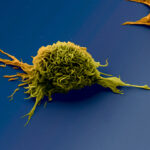Link to Pubmed [PMID] – 10545490
Int Immunol 1999 Nov; 11(11): 1863-72
Specific antibodies increase antigen uptake and presentation by antigen-presenting cells via the B cell receptor in B cells or FcgammaR in dendritic cells. To determine whether the interaction between antibody and antigen could influence the set of peptides presented by MHC II molecules, we analyzed the presentation of different CD4(+) T cell epitopes of hen egg-white lysozyme (HEL) after the capture of immune complexes formed between HEL and seven different specific mAb. The 103-117 T cell epitope (I-E(d)) was specifically and selectively up-regulated by the D1.3 and F9.13.7 mAb that binds to proximal loops in the native structure of HEL. Furthermore, Ii-independent T cell epitopes exposed on the HEL surface (116-129 and 34-45, I-A(k) restricted) which require a mild processing involving the recycling of MHC II molecules were selectively up-regulated by mAb that overlap those T cell epitopes (D1.3 and D44.1). However, F10.6.6, somatically derived from the same germ line genes as D44.1 and exhibiting an higher affinity for HEL, was without effect on the presentation of the 34-45 epitope. An Ii-dependent T cell epitope buried into the tertiary structure of HEL (45-61, I-A(k) restricted) and requiring the neosynthesis of MHC II was up-regulated by high-affinity mAb recognizing epitopes located at the N- or C-terminus of the T cell epitope. These results strongly suggest that (i) the spatial relationship linking the T cell epitope and the B cell epitope recognized by the mAb, (ii) the intrinsic processing requirements of the T cell epitope, and (iii) the antibody affinity influences the presentation of a given T cell epitope.


